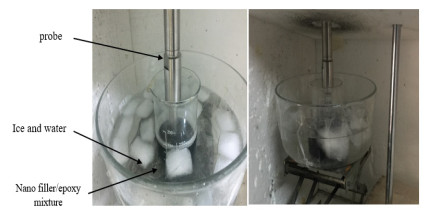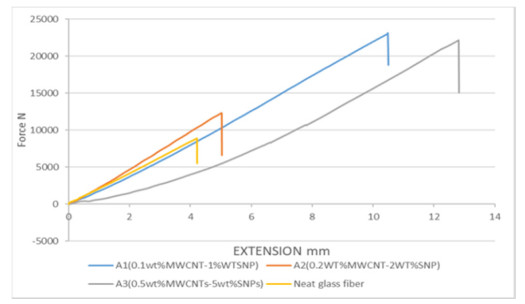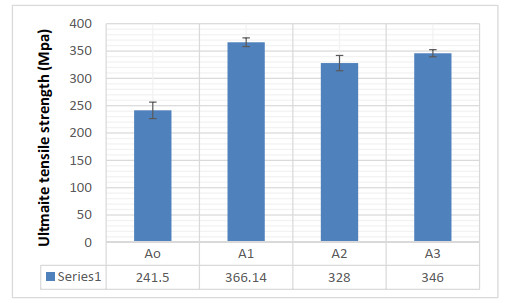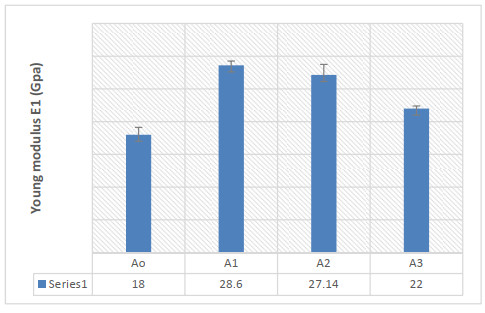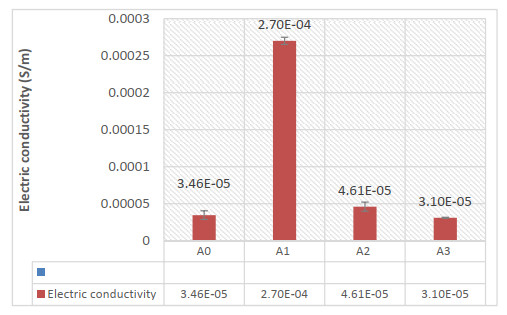Development of composite materials has increased rapidly in different fields of sciences. This offers new structures of reinforcement materials and risen. More recently, the use of nanomaterials as reinforcement materials has proliferated. This research studies the mechanical properties and electrical characteristics of hybrid composite materials. Glass reinforced epoxy (GRE) was used as a basic composite in addition to the nanomaterial which was mixed with the risen using different percentages. Multi-wall carbon nanotubes (MWCNT) and Silica (Silicon Dioxide SiO2) were used as nano-particles. The ratios of nano-particles used to reinforce the Epoxy were (0.1, 0.2, and 0.5%) of weight ratio for MWCNT and (1, 2, and 5%) of weight ratio for Silica nanoparticles (SiO2). The results showed that the ultimate strength for GRE with 0.1 wt%MWCNT-1 wt%SiO2 was the highest, while Young’ modulus for GRE with 0.2 wt%MWCNT-2 wt%SiO2 was the highest. In addition, the samples with 0.1 wt%MWCNT-1 wt%SiO2 showed a magnificent value of electric conductivity. Having finished the mechanical tests, the fracture surfaces were comparatively examined using scanning electron microscopy (SEM).
1.
Introduction
In recent years, because of its high-performance, the utilization of nanotechnology has been developed in different domains and applications like electronic, electric, telecommunications, and many other civilian applications. Polymer nano-composites offer improved mechanical, thermal, barrier and flame retardant properties, compared to conventional filled materials [1]. As a part of composite materials, glass fibers present desired mechanical properties of the overall system of about 15 to 20% lighter than traditional metals. GFRPs are used as alternatives for steel and aluminum in many industries, due to its lightweight. GFRPs are considered an electrical insulator in its origin; however, the modification of the matrix of GFRPs with electrically conductive carbon nanotubes (CNTs) can make an improvement in the system in a total of its mechanical and electrical properties. A volume content below 1% of CNTs in the composite produces a high electrical conductivity. For this reason, CNTs are extending the usage domain of GFRPs with a modified matrix in the fields of electronics, biomedical, automotive and aerospace industries [2]. Ming-Chuen Yip et al. [3] studied the achieved of adding CNT with various percent of hardened resin (Phr) (0.25, 0.5, 0.75, and 1 phr) to fabricated CNT/GPRP composite laminates on interlinear shear strength (ILSS) and flexural strength. They found that 0.75 phr of CNT gives the best mechanical properties where the ILSS and flexural strength improved 15.7 % and 9.2% respectively. M.R. Ayatollahi et al. [4] made an experimental study on the influence of the aspect ratio of MWNT on the electrical and mechanical characteristics of Epoxy/MWNT composite plates. They confirmed that the aspect ratio has a great impact on the electrical and mechanical characteristics of nanocomposite materials with many better properties for MWNTs of smaller size. M Rafiee et al. [5,6] studied mechanical, vibration, and damping properties of laminated fiberglass/epoxy composites modified by a wide range of carbon Nano fillers, including multiwall carbon nanotubes, graphene oxide, reduced-graphene oxide, and graphene nano platelets experimental results exhibited that the damped natural frequencies and tensile properties in the nanocomposites increased with an increase in the nano loading. Mohammed F. Uddin & C.T. Sun [7] investigated the effect of adding 15 wt% of Nano-silica to unidirectional glass/epoxy composite. This helps to improve the longitudinal tensile strength and transverse tensile strength by 11% and 41% respectively. A. Haque et al. [8] investigated the effect of adding 1 wt% of Nano–silica to glass/epoxy laminate. These authors observed that the magnitude of shear strength, flexural strength and fracture toughness increased by 44%, 24%, and 23% respectively. Dutta et al. [9] investigated the electrical and dielectric properties of nanocomposites made from polypyrrole–silica (PPY-SNP). Their study dealt with the properties mentioned above like functions of frequency and temperature for different PPY concentrations. The researchers observed that the magnitude of the conductivity and temperature variation for the composite are precisely different from its components, i.e., the polypyrrole and SiO2. They showed that a large value of the dielectric constant of approximately 4800 at 30 KHz and at room temperature can be obtained when the concentration of silica being the highest. This reverts to the inhomogeneous behavior of nanocomposites.
In the present, specialists are investigating another style of nanoparticles, particularly the synergistic impact of nanoparticles. If two types of nanoparticles grow together and implementing them as reinforcement fillers, this integration is called hybrid nanoparticles. At times, when two nanoparticles used together to reinforce the composite system without allowing them to grow together, they could react with the polymers either separately or synergistically resulting in properties that are better than single type nanoparticles reinforcement. Xiao et al. [10] accomplished uniform dispersion in an easy way with self-reinforced crystalline of nanocomposite materials and the synergistic impact of fullerene (a form of carbon) and CNTs. The mixture of MWCNTs and silica show an improvement of about 15.6% in elastic modulus for tensile, compared to the composites reinforced with only MWCNTs. Yao-Wen Hsu et al. [11] studied the MWCNT-grafted silica Nano architectures which was efficient to improve its mechanical properties, heat resistance, and electrical resistivity.
As reviewed above, few research works have experienced the role of (CNT or SiO2 nanoparticles) on the electrical and mechanical characteristics of composite materials and most of those works discussed the effect of (MWCNT or SiO2 or both) on mechanical properties. Detailed information has not been notified for the observed trends, including results with contradictions until the present time. The effect of hybrid nano (MWCNTs/SiO2) by different weight fractions on electrical and mechanical characteristics of Epoxy/MWCNT/SiO2 nanocomposites reinforced with woven glass fibers are considered in this study. Test specimens with different combinations and contents of MWCNTs, precisely 0.1, 0.2 and 0.5 wt%, were prepared to evaluate the proper amounts of reinforcement. Sonication method was used to prepare the samples.
2.
Materials and methods
2.1. The materials used
Epoxy was selected because of its high mechanical, thermal and electrical properties. Epoxy is widely used in many industrial branches. EPL1012 Epoxy and EPH hardener from AMP composites LTD [12] were employed. The MWCNTs and SiO2 were supplied by Neutrino [13]. The nanoparticles of MWCNT were 10–30 nm average size and 10–40 nm average length and purity of 95%. While the SiO2 particles were of 25 nm average size, 180–270 m2/g specific surface area and 99.999% purity. Woven plain glass fiber (200 g/m2 surface density) was utilized for the composite reinforcement.
2.2. Specimen preparation
The samples prepared for this work are divided into three different combinations: The first group is the woven fiberglass/Epoxy. The second group includes nanoparticles/Epoxy. The third group is the woven fiberglass–nanoparticles/Epoxy. The following steps are described the procedures of fabricating the samples.
A—The first type of samples was fabricated from neat fiberglass laminated (without nano). A mechanical stirring machine (HEIDOLPH RZR2102) was used to stir the resin and hardener aided by a magnetic mixer at 150 ± 10 rpm for 300 s and then degaussed in an oven to remove any air bubbles trapped in the plate. The plate of the composite laminates whose dimensions was (30 cm × 25 cm) was made using hand lay-up technique in a mold at laboratory conditions. Before removing the laminates from the mold, they pressed for 1 h. After that the laminates were left to cure for 7 d at room temperature. The fabricated plate consists of 16 plies of fiberglass.
B—The second type of samples is nanoparticle/Epoxy. The nanoparticles of MWCNTs and SiO2 were dispersed of different weight percentages in the resin using a mechanical stirring machine. Then a HIELSCHER UP400S ultrasound sonication device shown in Figure 1 was used. The required sonication time which depends on the weight fraction of the nanoparticles in the resin was used in order to provide suitable energy for separating agglomerated nanoparticles and getting appropriate dispersion. Regarding to the MWCNTs, different percentages of weight fraction were used including 0.1%, 0.2% and 0.5% which were added gradually to part of the epoxy and mixed by mechanical stirring for 300 s at 200 rpm. After that, the mixture was sonicated by an ultrasonic probe for 50, 55, and 65 min at a power of 70 watts.
As shown in Figure 2, the mixture was placed in iced water container during the sonication process to prevent overheating of the mixtures during the sonication process. The process was set to be switched on/off every one-second interval. The same steps mentioned with MWCNTs was repeated with the SiO2 nanoparticles which was added to the resin with weight fraction percentages of 1%, 2% and 5% excepting the sonication process. Having added the nano-fillers to part of the epoxy and mixed mechanically, the mixture of SiO2/Epoxy was sonicated at a power of 70 watt for 1800 s. Afterward, the hardener agent was added to the mixture and mixed mechanically with degassing. Post the sonication process, a suitable amount of hardener was added to the mixture and then mixed uniformly for 300 s at 150 rpm by means of a magnetic mixer. Finally, a vacuum chamber was used for 10 minutes to remove any bubbles.
C—The third type of sample, was made from hybrid nano resin reinforced by woven fiberglass. The same technique (hand layup) was used to fabricate the laminated composite material as for the previous samples without using nanomaterials.
After fabrication of the composite plates, the specimens were cut using water jet saw according to ASTMD3039 [14] and ASTM D257 [15] for tensile and electrical testing respectively.
2.3. Mechanical characterization
Specimens (type I) were manufactured according to the ASTM D3039 [14] for tensile testing to determine the tensile strength, elastic modulus, and the failure strain of the nanocomposites. A load cell of 50 kN gauge was used to execute the tensile tests with Instron universal apparatus. A 50 mm gauge length extensometer was used to determine the strain from the extracted data.
2.4. Electrical characterization
An HP Impedance Analyzer E4980A was used to drive the dielectric properties of the specimens. The Agilent E4980A precision LCR meter and the 16451B dielectric test fixture were used to carry out the measurements by the assistance of the dielectric constant measurement program. The capabilities of the LCR meter is for measuring is within 2 MHz. The test samples are of disc shape with a diameter of 50 mm and a thickness of about 5 mm. The specimen data was analyzed using a contact electrode method, using a rigid metal electrode. Variable frequencies ranging from 1 kHz to 1 MHz were used in the measurements in accordance with ASTM D257 [15] standard. Before the test begins, a vacuum chamber was used to dry all specimens at 70 oC for one day. At each given frequency, the specimens were tested 10 times, recording an average value with the HP impedance analyzer.
2.5. Scanning electron microscopy (SEM)
The fracture surfaces of the composite combinations obtained from the mechanical tests, were detected comparatively by scanning electron microscopy technique (SEM) using (Tescan VEGA-II SBU) with information related to the state of hybrid nano dispersion.
3.
Experimental results
3.1. Result of tensile test
It is generally supposed that the mechanical properties of composites should be improved by the addition of CNTs [26]. In addition, as observed in earlier investigations; incorporation of nano silica can increase the tensile strength and elastic modulus in polymeric composites [7,8]. Three specimens were tested for each type to obtain the tensile properties of fabricated samples as described in Table 1 shown below. The samples were named according to their combination.
Figure 3 shows the relation between the applied force and the sample extension. As presented in Figure 3, the strength and stiffness of woven fiberglass/epoxy composites reinforced by hybrid nano (MWCNTs–SNPs) compared with the results of the neat fiberglass composite material improvement is noticed in the tensile properties after the addition of MWCNT–SNP hybrid nanoparticles.
The best improvement was for the specimens with 0.1 wt% MWCNT + 1wt% nano silica, they show a significant improvement for the tensile properties. In addition, when the MWCNT fractions increase, the purpose of improving tensile characteristics decrease compared with lower fractions. Figures 4 and 5 comparatively show the tensile strength and modulus of specimens at different applied loadings.
As it is clear, greater tensile properties are presented in all specimens containing hybrid nanoparticles compared with the neat specimen. In the sample A1 which contains (0.1 wt%MWCNT –1 wt%SiO2), a noticeable increase was obtained in the strength. The percentage of improvement in tensile strength and modulus for composites with (0.1 wt%MWCNT–1 wt%SiO2) were 34% and 27.5% respectively if compared with the neat glass fiber/epoxy composites. It was observed that, when content of the nano-SiO2 increases, firstly the tensile strength and elastic modulus take on an increasing trend and then decrease. Secondly, because of agglomeration phenomena of MWCNTs, the particle agammaegations, related local stress concentrations and the average tensile strength reduce. In other words, as the weight percentage of MWCNT increases, the tendency of tensile properties development decreases. The results proposed a new way of advanced increase in tensile properties of composite materials, by employing hybrid nanoparticles utilizing the synergistic role of hybrid nanoparticles. The results showed that the optimum type of hybrid nano with woven fiberglass is (0.1 wt%MWCNT–1% SiO2) which is great choice of alternative a new material.
3.2. Result of electric conductivities
The measurement of electrical conductivity (σ) was done as described previously in section 2.4. The effect of the content of hybrid (MWNT–SiO2) on the electrical conductivity was investigated as shown in Figure 6. It is clear from this figure that the conductivity increases dramatically with a Hybrid nanocomposite compared with neat composite material. These results show that the filler content 0.1 wt% of hybrid nano reaches a threshold of electrical percolation and a conductive which reduce the values of electric conductivities is should be due to more conglomeration of the MWCNTs and also more contact resistance between particles.
3.3. Result of SEM
SEM images gave premier information about failure modes and the effect of the size of particles on fracture behavior and the electrical behavior of the hybrid nanocomposite samples. The Fractured samples were analyzed within SEM to examine the MWCNT–nano silica–glass fiber–epoxy interface region and the basic failure mechanism. Figure 7a, b presents the increment of mechanical characteristics where the reinforcing effect of silica–MWCNT due to uniform dispersion of particles in the resin was shown. On the other hand, the subsequent decrease should be referred to the gradual agammaegation of silica–MWCNTs at higher load cases as shown in Figure 7c, which resulted in the great stress concentration and easy crack propagation in the resin matrix. Figure 7 are clearly show that the matrix covers the fiber, therefore it's difficult to distinguish between them except in Figure 7b. In addition to that accumulation may be happened at high concentration which explain why the properties drop at that ratio. SEM images arise from the surface in approximately 10 nm, so the areas between fiber and matrix still no clear in most of images.
4.
Conclusions
It can be observed that increasing the content of nano-SiO2 causes the following: Firstly the tensile strength, elastic modulus strength, and electric conductivity adopts an increasing trend and then decreases as described by several researchers [16]. Secondly, the agglomeration phenomena of MWCNTs causes reducing of the particle agammaegations, related local stress concentrations, and the average tensile strength. For example, in the case of increasing the weight fraction of MWCNT in the other reinforced specimens, the magnitude of growth in the tensile characteristics decreased. Previous results [10] showed that the tensile strength for 0.9 wt% of nano silica and MW carbon nanotubes were 0.612 and 0.570 GPa, respectively. The tensile modulus of the specimen with 0.9 wt% of single-type nano silica and MWCNT were 65.12 and 63.87 GPa, respectively. The results proposed a new conduction for further increase in the tensile characteristics of composite material, by combining hybrid nanoparticles utilizing synergistic effects of hybrid nanoparticles, and from this result the optimum type of hybrid nano with woven fiberglass, was (0.1 wt%MWCNT–1%SNPs) which is great choices of alternative a new material to develop the satiable industries.
Acknowledgments
The authors wish to thank Mustansiriyah University (www.uomustansiriyah.edu.iq) and in particular College of Engineering for the use of facilities in their labs.
Conflicts of interests
The authors declare no conflict of interest.
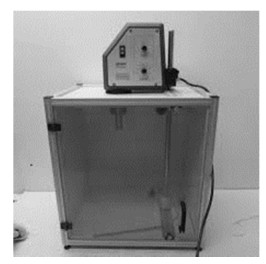









 DownLoad:
DownLoad:
